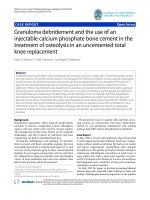research and development effectiveness evaluation model grassroots organization dedicated to the treatment of prisoners in hospitals some provinces - cities 2011-2012
Bạn đang xem bản rút gọn của tài liệu. Xem và tải ngay bản đầy đủ của tài liệu tại đây (305.76 KB, 33 trang )
INTRODUCTION
1. Urgency of PhD thesis
The management of health, health care, medical treatment for
prisoners is a humanitarian policies of the Party and State. This
shows the superiority of the Vietnamese socialist state, the moral
tradition of Vietnam and ensure the human rights of prisoners. Party
and State have been institutionalized through the point of view of the
system of the State, the Government and the Ministry of Public
Security.
Currently, the health system has been deployed to police all the
prisons in the country with 01 hospitals and 128 clinics for
examination and treatment of prisoners. However, no medical police
last line to treat prisoners. Every year, the state hospitals to medical
treatment, regular checks for tens of thousands of prisoners by prison
infirmary moved to. However, the actual medical examination and
treatment for inmates at the hospital still faces many difficulties and
shortcomings, such as management, custody (information provision,
suicide, escape from the hospital, to more manpower to guard),
affects the psychology of the other patients are treated by general
hospitals and specialized activities of the hospital has not been built
exclusively for the treatment of prisoners. On the other hand, funding
health care and treatment for prison inmates that the direct payment
to hospitals is higher than specified. Therefore, we conducted a
research topic: "Research and development effectiveness
evaluation model grassroots organization dedicated to the
treatment of prisoners in hospitals some provinces/cities (2011-
2012)”
2. Objectives of the study
1. Describe the situation and needs medical organizations,
medical treatment for prisoners (2009-2010).
1
2. Develop, implement and evaluate the effectiveness of
initial organizational model treatment facility for inmates in
provincial general hospital (2011-2012).
3. New contributions to scientific practice of doctoral PhD thesis
- Thesis assess the situation and needs of organization health
care and treatment for inmates at the prison clinic and hospital.
- Develop, implement and evaluate the effectiveness of initial
organizational model treatment facility for inmates in provincial
hospitals.
4. Dissertation Layout
The dissertation consists of 127 pages (not including
references, appendices), the structure of 4 chapters:
Background: 02 pages
Chapter 1. Overview: 33 trang
Chapter 2. Subjects and Methods: pages
Chapter 3. Results: pages
Chapter 4. Discussions pages
Conclusions: pages
Recommendations: page
2
Chapter 1
OVERVIEW
1.1. Demand and medical institutions, medical treatment of
inmates
1.1.1 . Demand for medical examination and treatment of prisoners
1.1.1.1. Some concepts and terminology
- Prisoners include detainees in detention centers, home detention,
prisoners in the prisons, detention camps, campers facilities and
student education reform schools.
- Detention facilities include: Detention, detention centers,
educational institutions, reformatories and detention. The Prisons,
detention centers, educational institutions, reform schools by the
General Department of Police Enforcement and Criminal Justice
Support, Ministry of Public Security to directly manage.
- Disease : According to the WHO definition: "Disease is the
imbalance in the body and spirit under the influence of a range of
external factors and internal environment on the human
environment."
- Disease model: A model of social illness, a community, a nation
that would be a set of all the imbalances in the body and spirit under
the influence of these factors appear in different communities,
societies, countries that in a certain period of time.
1.1.1.2. Demand for medical examination and treatment of prisoners
in some countries in the world
So far, in every country there are concepts, how diverse,
3
flexible to suit each stage, the development context of the country.
Inmates in countries around the world in addition to medical
examination and treatment at the prison medical facility is in need of
medical examination and treatment at the state hospital.
1.1.1.3. Demand for medical examination and treatment of prisoners
in Vietnam
- In recent years, morbidity, medical needs and treatment of prisoners
is very large. Due to ill inmates from being caught in the community,
particularly the rate of drug addiction, tuberculosis, HIV/AIDS and
hepatitis B, C are very high compared to the community (about 10-
20 times).
- Causes of death in prison is mainly due to HIV/AIDS. The main
cause of death was tuberculosis 2. This is one of the characteristics of
the disease model prisoner. Infectious diseases are major proportion
of the morbidity of prisoners.
1.1.2. The medical examination and treatment for prisoners
1.1.2.1. The medical examination and treatment for offenders in
some countries in the world
Health care for prisoners in several countries around the
world, especially the developed countries have achieved significant
accomplishments. Health care for prisoners in different countries,
while others have held the prison health care system, but primarily
due to the state health sector undertaken and implemented methods
also vary but mainly on management illness while in prison and
manage new epidemics arise from inmates in prison.
4
1.1.2.2. The medical examination and treatment for prisoners in
Vietnam
Responsibility for the medical examination and treatment for
prisoners firstly by the Ministry of Public Security (the prison
infirmary) assumed, the medical establishments of the Ministry of
Health is responsible for coordination with the Health Ministry
prison police: Physicals, examination assessment, prevention and
treatment for inmates at the hospital from district to provincial and
specialty hospitals are defined in criminal Law Enforcement in 2010
and the Decree of the Government. This is specific to the prison in
Vietnam, the medical examination and treatment by the medical
system police assume, in addition to a number of countries around
the world, medical examination and treatment for the inmates by
prison medical assumed (Department of Justice).
1.2. The organizational model treatment facility for prisoners
1.2.1. The organizational model for the treatment of prisoners in
several countries around the world
Medical examinations and treatment for inmates by prison
medical assumed. Disease prevention and disease prevention by the
Prison Director decision. Some dangerous diseases such as
HIV/AIDS, hepatitis separate detention were transferred to hospitals
or infectious state such treatment in Poland, Egypt Some countries
have organized arrangements for the treatment reserved for inmates
in state hospitals such as Spain, Thailand the layout is now suitable
to guarantee professional requirements and discover detention,
treatment for offenders.
1.2.2. The organizational model for the treatment of prisoners in
Vietnam
5
1.2.2.1. Some legal documents related
Law enforcement Criminal: 53/2010/QH12 and Decree No.
89/1998/ND-CP and Decree No.: 64/2011/ND; Joint Circular No.
12/TTLB ; Joint Circular No. 04/2010/TTLB-BCA-BYT , Decision
No.: 910/2004/QD-BCA (X13), Decision No.: 799/2004/QD-BCA
(H11).
1.2.2.2. System organization of prison health care in Vietnam
- Department of Defense: Currently, the Ministry of Defence
managed 21 prisons, detention houses 54 scale: 10/remand homes.
- The Ministry of Public Security has 70 detention centers , 696 home
detention, jail 49 6 and 4 educational institutions reformatories.
6
Chapter 2
SUBJECTS AND METHODS
2.1. Subjects, materials, location and duration of study
2.1.1. Study subjects: The organizational model treatment
facility, treatment services for prisoners; Leaders and Health
Administration, the Bureau of the Ministry of Public Security
Business, Criminal Investigation Department of the Ministry of
Defense; the Board of Directors of the hospital, the prison leadership,
staff leadership of the prison infirmary, medical staff of the prison
infirmary and hospital participated examination and treatment for
prisoners, the inmate medical examination and treatment at the
hospital.
2.1.2. Material Research
In the research process using many materials such as legal
documents relevant reports, data and documentation of the health
management, health care, medical treatment for prisoners.
2.1.3. Study sites
- Location of study situation: At 10 hospitals provinces/cities; 5
district hospitals, 5 specialized hospitals; 6 police hospital; 31 prisons
(13 detention centers, 15 prisons, 02 educational institutions,
reformatories 01).
- Location of deployment models: From the hospital province/city
has investigated the situation, choose 6/10 to the hospital deployment
model grassroots organization dedicated to the treatment of prisoners
and evaluation initial performance: Dien Bien, Vinh Phuc, Hai
Duong, Ninh Binh, Ha Dong, Binh Thuan.
7
2.1.4. Time study: 4 year study period (from 1/2009 to 6/ 2012)
2.2. Research methodology
2.2.1. Study design: Thread 2 uses the research design:
- Cross-sectional descriptive study combined quantitative research,
qualitative and descriptive retrospective based on secondary data.
- Research interfere with the development, implementation and
evaluation of effective organizational model treatment facility at the
hospital provinces/cities selected.
2.2.2. Sample size and sample: 26 hospitals (10 hospitals
provinces/cities, 05 district hospitals, 05 specialized hospitals, 06
police hospital); 31 prisons infirmary doctor prisoner transfer,
treatment in 26 hospitals studied.
The samples for investigation socialistic 100 medical staff
working in the prison infirmary and 60 medical staff of the hospital
were studied; 100 leaders studied prison, 170 prisoners.
2.2.3. Research Methodology
- Retrospective method described: General medical examination and
treatment for inmates in recent years.
- Cross-sectional descriptive method: A survey to describe practical
issues related to research content.
- Sociological Methodology: Interviews with 100 medical staff
working in the prison infirmary and 60 medical staff of the hospitals
studied; 100 leaders prisons, 170 inmates. Scientific seminar, consult
experts.
- Methods of logic.
- Methods of intervention.
2.2.4. The study variables and indicators for assessment
Situation of medical examination and treatment for prisoners
(2009-2010): Total number of prisoners for medical examination and
treatment, mortality, morbidity structure at the clinic, hospital, total
number of prisoners moved medical examination and treatment at the
8
hospital
2.2.5. Measures to control bias: Design full kit, encryption votes,
investigator training, cleaning before check processing
2.2.6. Methods of data processing research: The data were
processed by the software biostatistics: 6.04 Epiinfor, Excel.
2.2.7. Research Ethics
- This is the study of the organization of the base model for the
treatment of prisoners at the hospital, in the research process and the
results of the study did not affect the mission and activities of the
prison and the hospitals as well as psychological health of the
inmates, medical staff of the prison and hospital leaders prisons.
- Those who were interviewed on a voluntary basis, the information
collected from individuals only for research purposes, is encrypted on
your computer and confidential (secret).
2.2.8 . Research organizations , research force participation
As the subject is in the policy of the Party and State , Ministry of
Public Security as well as the agency's mission . In the process of
implementing threads , with the collaboration of researchers
investigating the prison officials . Subject has received support ,
facilitated by the prison , the hospital and the staff working in prisons
and hospitals studied .
2.2.9. Limitations of the study
- Due topic deployed in different locations so that research
institutions are not fully explored with experts.
- Interviewers include prisoners, medical staff prisons, leaders of the
prison medical staff of the hospital, the comments are mainly based
on personal subjective observations of each person, so the reliability
of the opinion is limited.
9
Chapter 3
RESULTS
3.1. Current situation and needs medical organizations, medical
treatment for prisoners (2009-2010)
3.1.1. Real situation needs examination and treatment of prisoners
(2009-2010)
* 31 In the prison infirmary being studied:
- Currently the only team without detention camps organization,
organized the prison camps, educational institutions, reformatories
organized subdivisions, campus: Block 64 distribution prison/15
prison; Block 04 educational institutions have distributed/02
education establishments. Block has 02 distribution reformatory
reformatory. Total number of health workers in prisons study is 395
people, including 78 doctors, 32 pharmacists have a university
degree, the rest of the other officers.
- Evaluation of the leaders of the prison on the medical staff of the
prison clinic: Lack of failing to meet the requirements: Prison Block:
57.78 %; Bloc prisons: 60 %; Block institution education-reform
schools: 46.67 %. And sufficient to meet the requirements: Prison
Block: 42.22 %; Block detention: 40 %; volume basis reformatory
education: 53.33 %.
- Evaluation of the prison leadership in quality medical equipment:
good quality and meet the requirements: Prison Block: 68.89 %;
Block detention: 80 %, Bloc educational institutions-reformatory:
46.67 %. Poor quality and did not meet the requirements: Prison
Block: 31.11 %; Block detention: 20 %; volume basis reformatory
education: 53.33 %.
- Regarding the quality of the infrastructure of the clinic: Good
quality, meeting requirements: Prison: 77.78 %; detention: 65 %
Base reformatory school education: 46.67 %. Poor quality, not meet
requirements: Prisons: 22.22 %; detention: 35 % base reformatory
10
school education: 53.33 %.
Number of doctor visits, medication dispensing, treatment of
prisoners at the detention facility clinic increased much over the
years. Morbidity: Prisons: TB ratio: 2009: 5.11 %, 2010: 5.32 %
Percentage of HIV-infected patients: 2009: 7.1%, 2010: 6.8 %.
Detention center: TB ratio: 2009: 7.21 %, 2010: 7.14 % Percentage
of HIV-infected patients: 2009: 6.89 %, 2010: 5.98 %.
* At 26 hospitals studied: Total number of beds reserved for inmates
at the hospital is 497/8.780 (5.66 %). Accordingly, a police hospital
bed for about 20-24; Hospital province/city spends about 22-24 beds;
district hospitals, specialists spend about 10-12 beds for the treatment
of prisoners. In accordance with technical distribution of MOH: 80.7
% Research Hospital is capable of diagnosis and treatment, 19.3 %
are research hospitals can not afford diagnosis and treatment should
must refer the patient to a higher level.
- Proportion of hospitals are likely to study basic tests required to
meet diagnostic, therapy, hospital police, hospital provinces/cities,
specialist 100 % of district hospitals: 60 %. Rate of hospital
laboratory studies HIV testing regulations: Police Hospital: 16.67 %;
provincial hospital, city, specialty: 53.33 %. The hospital has 184
rooms arranged with 497 patient beds and 65 isolation rooms. There
are 22/26 hospitals comply with the number 1, 4/26 hospitals comply
with the number 2.
- Total number of health care visits at 02 hospitals in 2009-2010: 67
137 respectively; hospitalized Total: 8,364 respectively, the total
death toll: 886 people. TB rate increases over 02 years: 2009: 18.4 %
and 2010: 23.71 %. The rate of HIV-infected patients has increased
over 02 years: 2009: 48.16 % and 2010: 51.76 %. This ratio is
relatively uniform in the line of treatment.
* A compromise between the needs , status and clinic , treatment for
prisoners: Demand for medical examination and treatment of
11
prisoners in detention facilities clinics and hospitals are great. The
prison sentence illness mainly dangerous communicable diseases
such as HIV/AIDS, Tuberculosis, Hepatitis meet the real situation
of medical examination and treatment at the clinic for prisoner
detention facility is not guaranteed. Business medical examination
and treatment for prisoners in hospital no specific regulations,
unified.
3.1.2. Organizations examination and treatment for prisoners
(2009-2010)
Although no specific guidelines on medical examinations and
treatment for prisoners at the hospital, but the detention facility was
transferred to the object of the State hospitals in the area for medical
examination, treatment, regular checks. 100 % of the detention
facilities have clinics for medical examination and treatment for
prisoners. 100% of prisons, educational institutions, reformatories
chamber organized medical camps, division, campus, 58.06 %
detention facility organized medical camps chamber, division,
campus.
3.2. Develop, implement and evaluate the
eectiveness of initial organizational model
treatment facility for inmates in provincial
hospitals (2011-2012)
3.2.1. Model proposed facility dedicated to treating prisoners
provincial hospital/city
3.2.1.1. The grounds and principles for proposed model
- Pursuant to proposed model: Demand for medical examination and
treatment for prisoners , the legal documents related to Joint Circular
No. 09/8/2010 dated 04/2010/TTLB-BCA-BYT. Practical conditions
in the area; organized system of health care; Surface treatment
facilities in hospitals , detention operations work.
- Principle: The hospital police, military and medical residents to the
12
layout, room dedicated to treating prisoners in hospital; These places
have a detention facility in the area that will build a general treatment
for prisoners at the hospital and delivered to a detention facility
management, where there is only one at the detention facility,
construction of treatment reserved for prisoners in hospital, building
parks, dedicated treatment rooms for inmates in provincial hospitals,
cities and some specialized hospitals, district hospitals, depending on
the conditions of each hospital in the planning, land area hospital for
dedicated to the treatment of prisoners of unified application model
built to suit, the hospital can not arrange for the land they own to
unitary treatment for inmates; Proposed layout of the rooms at the
treatment: Office staff warden protection, visitation rooms, patient
rooms male, female patients division, department of infection,
treatment area detention room built specifically for the suspect, the
hospital arranged funds land to build parks, private treatment rooms
for prisoners in accordance with the provisions of the detention
business, building a legal framework : Department of Health Circular
-Defense-Police-Finance hospitals ensure state participation in
medical examination and treatment for inmates in charge of the
province, in the sick bed, rooms dedicated to the treatment of
prisoners of hospital beds payroll; may request special mode revenge
for the medical staff of the hospital for treatment for prisoners in the
room, private treatment in hospital.
3.2.1.2. Functions and duties of the treatment reserved for prisoners
- Functions for prisoner treatment: Ensure medical examination and
treatment as required of special expertise is dangerous infectious
diseases such as TB, HIV/AIDS ; Without prejudice to the general
operation hospital.
- Functional performance of Detention: Ensure detention operations
as prisoners not to escape from the hospital, information provision,
suicide
13
- Combined with hospitals: Do the administrative procedures,
hospital billing, hospital transfer and strengthen the nutrient regime
and coordinate medical treatment for prisoners.
3.2.1.3. Organization , staffing models and layouts
- Model name:
+ For the hospital, the unit dedicated to the treatment of prisoners:
PATIENT TREATMENT AREAS
(Prisons A - Detention B)
+ With hospital only dedicated to the treatment room prisoners:
PATIENT TREATMENT ROOMS
(Detention A)
- Payroll organization: Organization and staff of a dedicated
treatment zones are determined based on: decentralization tasks and
technical expertise for a dedicated treatment area; held real situation ,
the hospital's human resources, total of inmates treated at hospitals;
disease situation, structure and characteristics of industrial sickness
detentions.
- Equipment: Medical equipment, instruments orderlies, weapons,
tools, support, equipment and other activities.
- Treatment Process: Process 1 (Daily medical staff of the department
relating to areas , treatment rooms dedicated to the treatment of
prisoners and the implementation of technical expertise).
- The coordination between hospitals and detention facilities: Based
on the opinion of the medical staff and the hospital, proposed
regulations on coordination between hospitals and detention
facilities: a contract liability, regular consultations and briefings 6
months/time between hospitals and detention facilities.
14
3.2.2. Development of the model
3.2.2.1. Circular Issued Ministry of Public Security and the Ministry
of Health
According to Joint Circular No. 09/8/2010 dated
04/2010/TTLB-BCA-BYT of the Ministry of Public Security,
Ministry of Health guiding medical examination and treatment of
detainees, prisoners, inmates, school birth in medical facilities and
State According to the Ministry of Public Security for prisoners
suffering from serious illness, some hospitals has serious to moved to
higher levels of government, but this condition has not been met in
many years due to lack of funds in the construction of the hospital
room. So the situation is still prisoners fled away during treatment at
the hospital (In 2011-2012, had 8 prisoners ).
In 2012, according to the report of the detention facility with
1,896 beds, of which 1,065 beds to the prison infirmary, educational
institutions, reformatories and 831 of the infirmary bed detention
center with 301 treatment rooms at the clinic. Total viewed
examination, distribution of medicines for the inmates to nearly 3
million views, views of prisoner treatment in clinics in more than
140,000 views and medical treatment.
3.2.2.2. Deployment models in 6 general hospitals of provinces/cities
For a pilot implementation of the model, we selected six
hospitals of province/city represent regions of the country to organize
a dedicated treatment facilities for prisoners include: Dien Bien, Vinh
Phuc, Hai Duong, Ha Dong, Ninh Binh, Binh Thuan. The police have
been assigned to detention facilities in the area to coordinate with the
hospital to arrange location, scale, funding for construction. The
allocation of medical equipment and facilities of living, weapons,
tools support guaranteed by the Ministry of Public Security.
15
3.2.3. The effectiveness of the model
Evaluate the effectiveness of the model based on several
criteria: Industrial Service Guarantee detention, examination and
medical treatment; assessment questionnaires, economic efficiency
and social.
3.2.3.1. Initial results of operations of the model grassroots
organization dedicated to the treatment of prisoners in 6 general
hospitals of province/city
By the end of 6/2012 had 86/129co detention facility, in
which the detention center is 40/70 in general hospitals provinces;
prison 46/59 at the provincial hospital/city (32/46), district specialists
(14/46) with a total of 1,896 beds. 06 general hospitals in the
province, the city layout, private treatment rooms with Circular 04,
89 arranged rooms with 206 beds diseases. In the 02 years from 2011
to 2012 has treated 1,827 subjects turn, has responded to 18 detention
facilities. In 6 hospitals province/city conducted a pilot
implementation of the organization, a dedicated treatment room for
prisoners: There are 3 hospitals organize the construction
specification for the treatment of prisoners, 3 hospital not arrange
construction land should arrange separate unitary; 5 hospitals had
allocate funds to build, repair by the Ministry of Public Security, 1
hospital provincial People's Committees are arranged construction
cost (Ninh Binh).
16
Total number of times prisoners are treated in hospitals:
2009-2010: 1,818 respectively; 2011 to 2012: 1,827 respectively. The
total number of deaths in hospitals: 2009-2010: 280 inmates; 2011 to
2012: 281 prisoners. Total fled in hospitals: 2009-2010: 2 prisoners
(Ha Dong); 2011-2012: no subjects fled the hospital. Most detention
facilities and hospitals contract liability (79% & 90%) Mode
briefings, regular consultations (82% & 81.67%); Moving beyond the
hospital by specialists subjects, the same route (95% & 93.33%);
prisoners have been discriminated against (15%), non-discrimination
(85%); uncooperative prisoners (16.67%); Not have policies specific
to the medical staff of the hospital (100%).
The idea that the measures to strengthen the examination and
treatment of prisoners include: Construction of private treatment at a
hospital (93.00% and 91.66%), building regulations and coordinate
detention facilities and hospitals (61% and 71.6%); Strengthening
medical examination and treatment at the clinic (47% and 61.66%);
Adding manpower (56% and 75%). During the medical examination
and treatment for prisoners: The most difficult thing is the funds to
pay for the hospital (81% and 91.66%) in the management of
prisoners (68% and 78.33%); Care, feeding (71% and 86.66%).
Interested medical detention facilities: 170/170 (100%) assessed as
being. The discrimination against prisoners: 167/170 (98.23%)
without discrimination, with 3/170 (1.77%) have been the object of
discrimination. The process of care in the hospital: 170/170 (100%)
rated as good. Base area, treatment rooms reserved at the hospital:
97.64% guaranteed; 2.36% not sure. 67.64% when objects are
separate rooms for treatment at the hospital and are subject to 32.36%
in common with other patients.
17
* Dien Bien general hospital of province: The hospital treatment
rooms arranged inter-faculty each year in hospital infection,
including 5 rooms and 11 beds. Medical equipment has been well-
equipped as specified. There are separate rooms for police detention
Dien Bien province. In 2011-2012, organized the clinic, 84 Views
treatment for prisoners and prisoners would not have fled in time of
treatment in hospital.
* Vinh Phuc general hospital of province: The hospital developed on
the treatment for prisoners with 8 rooms and 15 beds. This area is not
fenced in private security. This treatment area no rooms reserved for
police remand Vinh Phuc province. Already, the site has arranged 01
nurses working on the payroll of Glory camp. Hospital rooms feature
the closed toilet. Home medical equipment have also been equipped
as specified. Most difficult with this area is that the higher the paying
patients. In 2011-2012, 387 views multi treat prisoners, no prisoners
would flee.
* Ha Dong general hospital: Private Block has an area of about 500
m2, 20 rooms with capacity of 40 beds. Currently, the hospital has
served the medical examination and treatment for the inmates of the
camp: the detention center No. 1, 3, T16 and traij Thanh Xuan prison.
From 2011-2012, Ha Dong General Hospital has examined 789
prisoners respectively, for 381 inpatient visits, no inmates escaped
from the hospital.
* Hai Duong general hospital of province: The hospital entire
layout of the infectious disease department 3rd floor, including 10
rooms and 15 beds. Medical equipment has been well-equipped. In
2011-2012, has treated 462 prisoners, no prisoners would flee.
18
* Ninh Binh general hospital of province: had spent in the hospital is
a 2 storey concrete building, new building with an area of over 2000
m2 land for private treatment for prisoners of three detention
facilities: Ninh Khanh prison, reformatory schools and detention of
two police Ninh Binh province. This particular area has 40 treatment
rooms and 150 beds disease accounted for 25% of the size of the
hospital bed. Name of this particular treatment area is managed
directly Ninh Khanh prison's hospital and Ninh Binh province
responsible for the medical professional work.
In the private treatment room layout: visitation room, live
room, health room staff warden protection, room, male patients,
female patients rooms, infection prevention, private dining room for
the prisoners. Block and the rooms have been designed to protect
steel door. The patient rooms are designed according to the
requirements and professional detention: Having locked iron gate,
patient bed, electricity, water, sanitation, and water heater closed. In
02 years (2011-2012), the hospital has examined 808 prisoners
respectively, for 557 inpatient visits prisoners in hospital mortality
was 60 cases, no inmate escapes the duration of treatment in the
hospital.
* Binh Thuan general hospital of province: The hospital arranged for
the treatment of prisoners, including 6 rooms and 15 beds. Medical
equipment has been well-equipped, fenced in private security. In
2011-2012, most medical clinics, treating 1,005 prisoners, no
prisoners would flee.
3.2.3.2. Assessment model deployed areas, unit dedicated to the
treatment of prisoners in hospital provinces/cities
19
In 6 Hospital province/city has developed on the treatment of
prisoners specification, we found 2 hospitals deployment and
operation model is consistent, efficient: Ninh Binh general hospital of
province layout built specifically for the treatment of prisoners list.
Ha Dong general hospital unitary arrangements dedicated to the
treatment of prisoners.
Chapter 4
DISCUSSION
4.1. The situation needs and medical institutions, treatment for
prisoners (2009-2010)
4.1.1. Situation and needs medical examination and treatment of
prisoners (2009-2010)
- At the clinic 31 detention facilities: medical organization system,
treatment for prisoners under the Ministry of Public Security to stop
at the clinic level detention facility, currently only 01 hospitals for to
treatment for prisoners Chi Hoa hospital only to serve its own police
detention center of Ho Chi Minh City with 120 beds, tertiary- not to
treat prisoners. So, while the inmate disease beyond clinical expertise
will be transferred to the state hospital in the area for examination
and treatment.
Organization, staffing medical staff at the clinic: Total of
health workers mainly in mass detention and mass detention
(379/395 health workers). The number of doctors and pharmacists are
also concentrated in jail (97/125 physician 23/32 pharmacists).
Currently, the detention center is no research pharmacists. Health
workers are mostly nurses and pharmacists school. Percentage of
medical/clinical highest in the prison block (18.86 person/clinic) and
lowest in the detention block (6.61 persons/clinic). Similarly, the
percentage of physician/clinic of the prison block has the highest
proportion ( 3.53 persons/clinic) and lowest in the detention block
(1.46 persons/clinic). However, the proportion of
pharmacists/Infirmary lowest educational institutions (not
pharmacists) and highest in reformatories blocks (2.00
persons/clinic), and then to block camp cell (1.53 persons clinic).
20
According to the comments of the leaders of the detention facility on
the medical staff is insufficient and did not meet the required
percentage of 57 % . In fact the number of health workers but enough
structure in accordance with medical staff primarily intermediate
level, the percentage of healthcare staff have university degrees or
more lower , especially doctors and pharmacists university degree.
Therefore, the assessment only 43 % of health workers and meet all
requirements.
Regarding medical equipment and means of transport of the
clinic detention facilities: In recent years, the attention of the
Ministry of Public Security of investment, medical equipment of the
detention facility was additional equipment, but enhanced medical
staff have not been trained to use it fully effective punches of
equipment to enhance training, training.
In the workshop on health sector organizations detention
facilities are held at the General Department of Logistics-
Engineering, Ministry of Public Security, the majority opinion agreed
that health workers block detention facilities has increased high
ethics, operating in complex environments; inmates who violate the
law with full charges from infringing upon national security, social
order, economic crime, drug and particularly dangerous crimes ;
Vietnam prisoners are foreigners and violate the laws of Vietnam and
was treated by the law of Vietnam (2008 was 296 inmates).
Regarding funding for medical examination and treatment for
inmates: the health budget allocation increases with the increase in
accordance with the sliding scale detention and market prices. So, has
caused so much trouble for ensuring health cacco detention facility.
Every year, funding for the test cases in the risk of HIV/AIDS have
to do blood tests to detect HIV in accordance with Circular No.
05/2003/TTLT-BCA-BYT-BTC. Demand for medical examination
and treatment for prisoners at the clinic the detention facility is huge:
According to the survey 85% of inmates in need of health care and
health worries. On the bed occupancy rate: Although the clinic has
deployed extra beds Statistics payroll than prescribed bed, but the
21
utilization rate is still overloaded beds (prisons: 130.9 %; camps
detention: 147.0 %).
Morbidity of prisoners at the clinic is diverse and specific
dangerous infectious diseases such as TB, HIV/AIDS However,
testing for inmates with HIV/AIDS in the detention is not regular
basis due to physical conditions, financial difficulties and the
detention must actively coordinate with outside health agencies
periodically testing and sampling conditions only blood tests for
some prisoners in high-risk groups such as sex workers, injecting
drug addicts can not detect the number of prisoners with HIV in
detention . No funding drug tests and specific treatment for inmates
addicted to drugs, HIV/AIDS, lack of medical facilities protection
service rooms such as boots, gloves, masks A number of countries
around the world and propose conduct HIV tests for inmates at the
prison in the U.S
Due to technical distribution and qualifications at the clinic
the detention facility, inmates must move beyond disease expertise to
hospitals in the state for medical examination and treatment have
increased over the years (2009: 2698 people, 2010: 3,161 people) in
all detention facilities under study. The prisoners were transferred to
the hospital all the provinces, cities, district hospitals and specialized
hospitals near where the unit was stationed. The demand is huge
referral, so the receiving hospital doctor, effective treatment and
support for the work of the clinic for treatment and to ensure
detention operations. When moving objects away mainly treated in
hospitals provinces/cities. Rate prisoners with TB and HIV/AIDS in
the detention facility is higher than the community, to the media, peer
education, prevention and medical treatment of custodial care facility
implementation and deployment.
- At 26 hospitals studied: All hospitals in provinces, cities, first class
hospitals of the Ministry of Public Security to meet the basic
requirements for testing, diagnosis, treatment of prisoners and the
distribution technical levels. Therefore, the proposed construction of
the treatment reserved for inmates at provincial hospitals/cities is to
22
ensure appropriate professional requirements.
Regarding human resources, infrastructure and medical
procedures, treatment of prisoners in hospitals: medical staff is
responsible for coordinating with the hospital for the treatment of
prisoners, health care organizations, to test the hospital department
and the administrative procedures between detention facilities and
hospitals. Currently, there are no regulations specific to medical staff
working in the areas of treatment. There are police comrades 3-10 for
each specific therapy area hospital with guarding, escorting,
protecting the medical staff of the hospital to medical examination
and treatment performance of detention.
Inmates transferred to the main hospital in the police hospital
is 42 (2009), 52 (2010) vabenh district hospital is 32 (2009), 35
(2010). The disease bu the police to police headquarters hospital,
deployed new city (7/5 hospital of Dien Bien Provincial Police,
Police Hospital in Nam Dinh province) and Chi Hoa Hospital (Police
of Ho Chi Minh city) is the technical distribution of class III hospitals
expertise should not meet. When people from the hospital medical
transfer objects to hospitals, the post served by the hospital medical
work undertaken is guarded by the detention facility to take.
Morbidity of prisoners in hospitals like structure of the
disease at the clinic prisoner detention facilities, mainly tuberculosis,
HIV/AIDS and other infectious diseases. This result corresponds to
the findings of a number of countries around the world. In many
countries HIV/AIDS is a major threat to the health of prisoners.
HIV/AIDS, hepatitis, tuberculosis and other infectious diseases
through sexual creating enormous challenges for the prison
authorities. In Spain, the prisons are faced with the phenomenon of
smuggling drugs into the prison in two ways: by inmates after
carrying out work in the home or by offenders included in the group
25.9 % are drug addicts inject drugs. The rate of HIV/AIDS infected
prisoners in detention in 2000 was 5.1 %, in 2009 was 1.5 %.
4.1.2. Organizations examination and treatment for prisoners
(2009-2010)
23
All detention facilities have clinics for medical examination
and treatment for inmates. Bloc prisons, educational institutions,
reformatories chamber organized medical camps, division, campus.
The organization of the medical examination and treatment of
prisoners in detention facilities: Daily medical staff to medical, drug
development in the cell chamber and medical camps. In severe cases,
the clinic moved to the center. In case of necessity, the clinic will
move objects local hospital for medical examination and treatment.
Regarding the scope of cure: According to technical decentralization
of the Department of Health, Ministry of Public Security, the clinic's
detention facilities as health service facility for health services
management, health care, initial treatment , sanitation and other
public health work.
4.2. Develop, implement and evaluate the effectiveness of initial
organizational model treatment facility for inmates in provincial
hospitals (2011-2012)
4.2.1. Model proposed facility dedicated to treating prisoners in
hospital province/city
To build the model ensures a balance of principles: The
hospital police, military and civilian health care needs to the layout,
room dedicated to treating prisoners in hospital; These places have
many detention facilities on a province will build a common
treatment for prisoners at the hospital, and delivered to a detention
facility management, where there is only one at the detention facility,
the construction of dedicated treatment room for the prisoners at the
hospital, building areas, treatment rooms dedicated to cactu the
hospital in the province/city and a number of specialized hospitals,
district hospitals, depending on the conditions of each hospital
planning, land area hospital for the treatment reserved for inmates
who applied uniformly model built to suit, the hospital can not
24
arrange for the land they own to the treatment unit for the prisoners.
25









